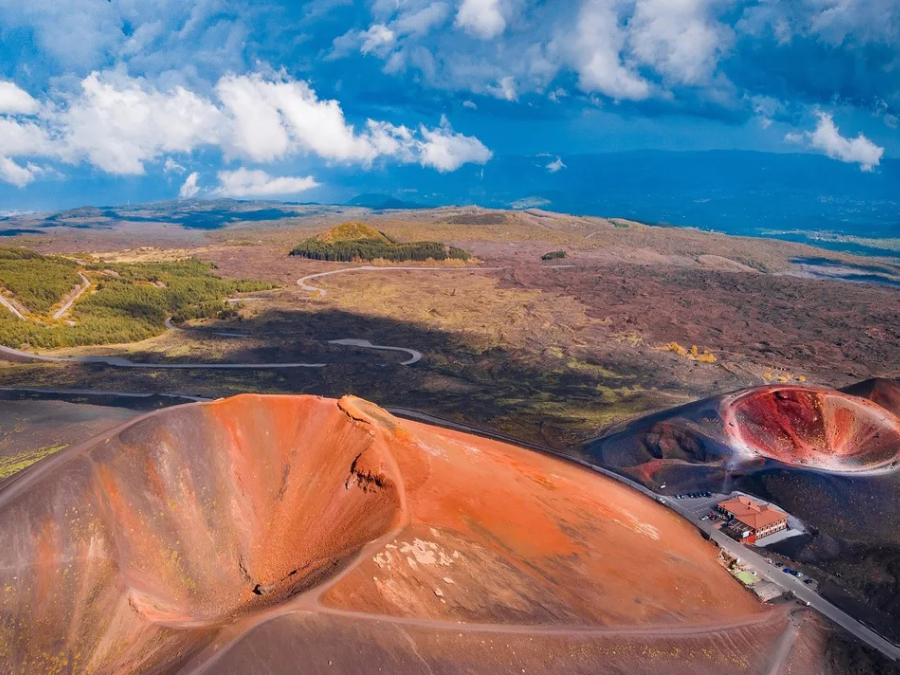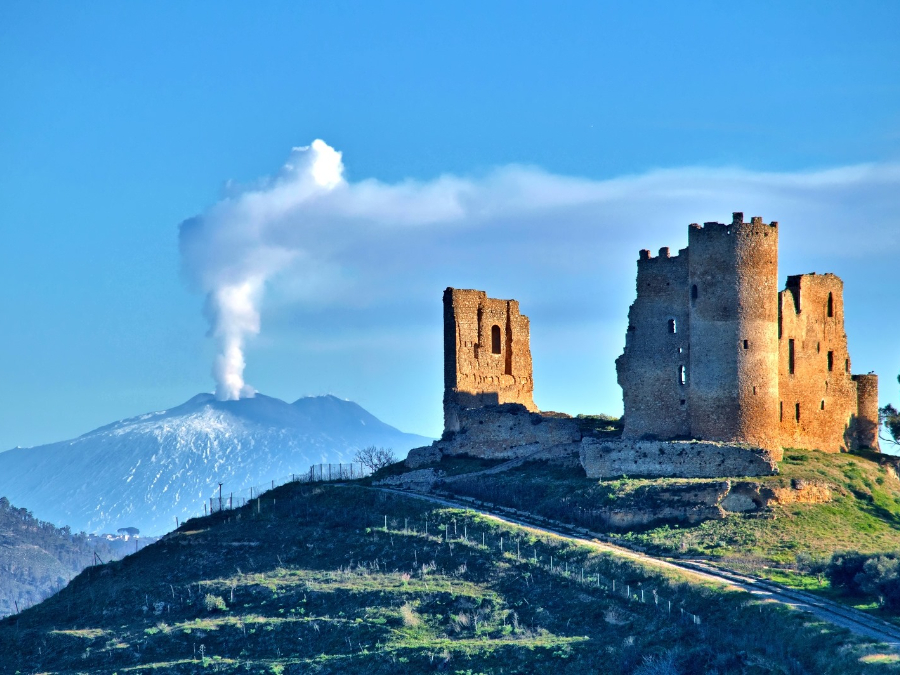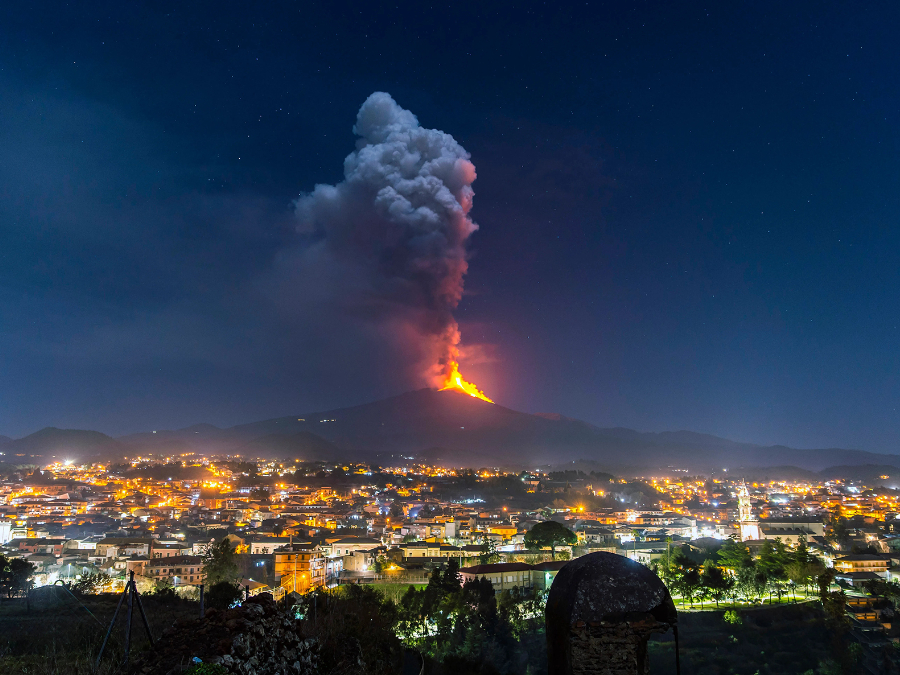

Etna's activity shows no sign of slowing down, yet people have learned to live alongside it. Photos of a volcanic eruption.
"Scassau a muntagna!" – That is, "The mountain has cracked!" – say the Sicilians. It's been barely a month since the news spread around the world: Etna has erupted again, with lava emerging from the volcano’s crater. This current period of activity began more than twenty years ago, and the last major eruption involving significant seismic activity and lava flow occurred in August 2025. Over the past two decades, the ash and rock released to the surface have increased the mountain's height by about 200 meters—77 of which were added in just the last five years. As a result, the Sicilian volcano now towers 3,403 meters above sea level and will undoubtedly hold more surprises in store.

During periods of calm, we can even explore Etna’s secrets from the edge of the crater
Reports of eruptions from Mount Etna, located between Catania and Messina, date back to ancient times. What’s most surprising, however, is that although most Sicilians have had the chance to admire the lava flows pouring from the volcano, very few have been directly affected by them. For locals, the real problem is not the lava itself, but the volcanic ash and pyroclastic material that occasionally blanket everything, along with the larger, sometimes destructive earthquakes. Of course, it's also worth noting that this volatile mountain periodically enriches the otherwise poor soil, and it attracts many tourists—bringing the locals income that far exceeds what agriculture alone could offer.

Etna's eruptions are often preceded by sudden, explosive releases of earthquakes, gases, and steam.
Did you know?
The volcanic activity of Italy’s Vesuvius, Sicily’s Etna, and Stromboli, which smokes on the Aeolian Islands, was long associated with the affairs—both trivial and serious—of the gods.

The discovery of Etna
The mystery of Etna's unpredictable activity has fascinated people from the very beginning. So much so that Empedocles, the philosopher from Agrigento, who was the first to study the volcano (as far as we can prove), threw himself into the crater in 423 BC because he could not decipher the mountain's secret.
In addition to the descriptions by Virgil and Ovid, that of the elder Pliny remains accurate to this day: "Among the mountains, Etna is a true marvel, for at night it constantly burns, and its fiery material has not run out after many centuries. Its peak is covered in snow during winter, and the ash it spews is covered by the wind."
Scientific records about the volcano became regular starting in the 17th century, so today we know much about it, but its eruptions are still difficult to predict. Among volcanologists, Etna is particularly popular due to the constant change and dynamics of its volcanic eruptions, which are closely linked to the complex tectonics of Southern Italy.

Etna is a classic stratovolcano, built up by an endless series of overlapping solidified lava flows. In the volcano's summit region, there are four large active craters, located close to each other. However, most of Etna's eruptions do not occur from these summit craters, but from smaller parasitic craters that lie on the slopes of the mountain. Today, alongside the central cone, we can observe around two hundred fifty to three hundred ash cones and parasitic craters—this number constantly changes, as new craters form with each eruption, while others disappear beneath the growing tephra.
In the summit region of the volcano, the most active craters are the Voragine and Bocca Nuova (which formed in the location of the former central crater), as well as the Northeastern and Southeastern craters. One of the distinctive features of Etna's activity is that the positions of the central craters change very little, and eruptions are frequent, while on the slopes, the locations of eruption points (parasitic craters) and the intensity of the eruptions are constantly changing. In the volcanic vents, the magma pushing upwards from deep within exerts immense pressure. If it finds a crack, it follows that path, fracturing the side of the mountain before reaching the summit craters, and then, emerging at the surface, it forms a parasitic cone at the eruption point. After the eruption, the lava solidifies firmly in the crack, forming hard lava plugs that block the previously existing pathways.
Eruptions
Eruptions of Etna have been recorded regularly for about 1,500 years, making it one of the most well-known volcanoes on Earth. Over the last 400 years, the nature of its eruptions has changed several times, as different types of magma have erupted from the volcano.
The eight long-lasting eruptions between 1600 and 1669 brought a significant amount of material to the surface. In the century following the 1669 eruption, Etna's activity was minimal; the volcano produced only a few minor eruptions.
The next major eruption occurred in 1755, during which numerous lava flows erupted from the central craters. The new active period began with three flank eruptions between 1763 and 1766. Between 1767 and 1865, large magnitude eruptions that brought significant amounts of material to the surface occurred roughly every ten years. A week after the last eruption, the area was shaken by an earthquake with a magnitude of 4.7 on the Richter scale, caused by movement along the fault lines beneath Etna (the Malta-Sicilian block and Messina-Giardini rift). This so-called Timpe fault line was often blamed for the volcano’s activity, but a direct connection has not been proven.
Since 1865, eruptions have occurred in periods (either in groups or sequences), and a common characteristic is that the last eruption in each series is the most powerful. The active periods are as follows:
-The period from 1874 to 1892, with the last eruption in 1892 being a gigantic one, producing 150 million cubic meters of lava and pyroclasts.
-1908–1928
-1942–1951
-1971–1993 – In this period, there were 13 eruptions, averaging about every one and a half years.
-The current eruption cycle began in 2001 and is still ongoing.